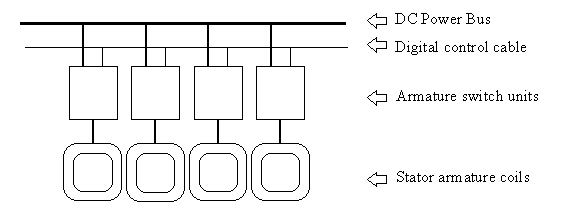Precise control of individual vehicles
November, 2003
"Control of individual vehicles is the very essence of PRT/DM" is the opening sentence of a submission by William Thurnbull of September, 2003, with the title "Control Software for PRT/Dualmode Systems is a critical need." I fully agree with his assessment of this critical need. What follows is an outline of how we may achieve the goal of precise control of individual vehicles.
I came to reflect on this subject after publication of my paper "Express Guideway Transit: A case for further development in transit automation" in the Journal of Advanced Transportation, Vol. 36, No. 2, pp. 157-167. (Spring/Summer, 2002) Express Guideway Transit (EGT) is not a PRT/DM system but an automated line haul system which is expected to provide non-stop transit service to many on-line stations at a high schedule speed in uncrowded trains. EGT also requires precise control of many vehicles.
Precise control is closely linked to the means of vehicle propulsion. Propulsion by linear induction motors (LIM) has been used in an Advanced Rapid Transit System in Canada since 1985 and for a number of years on some subway routes in Tokyo and Osaka in Japan. An alternative linear motor to LIM is the linear synchronous motor (LSM) which has been under development for transportation in Germany and Japan. LSM propulsion is favoured for magnetically suspended vehicles such as Transrapid because it can be integrated with its suspension magnets. With LSM there is also no need to transmit propulsion power to the vehicles.
Of the two existing linear motors used in transportation, the LSM appears to be best suited for precise vehicle control. The stator windings of a permanent magnet LSM are incorporated in the guideway structure and the magnets are mounted on the vehicle. Propulsion power is supplied to the stator windings from inverters placed along the guideway. Speed, acceleration and deceleration of the vehicles are controlled by the frequency and output voltage of the inverters. The vehicles are magnetically locked to the stator in the guideway, somewhat like teeth of a mechanical gear.
In standard LSM propulsion only relative short segments or blocks of the stator windings are connected to the inverter to provide multiple vehicle control along the guideway and to reduce power losses in unoccupied segments. One vehicle or train is permitted in a segment of the guideway powered by an inverter. This limitation does not meet the requirements of precision vehicle control.
Switched armature linear motor
Development of a variation of the permanent magnet LSM is proposed where the armature current of each stator pole is switched under direct central control instead of powered by an inverter.
The general layout of stator armature coils with armature switch units is shown above. The armature of this linear motor is divided into individual coils for each stator pole. The coils are connected to an armature switch unit which draws power from a DC power bus and is controlled by signals from a digital control cable. This arrangement provide independent magnetic flux control in each stator pole. To distinguish this linear motor from others it may be called switched armature linear motor (SALM).
Another feature of this linear motor is a stator pole pitch slightly larger than the distance between a pair of magnetic poles on the vehicle. For instance on a vehicle with ten magnetic poles, the pitch of stator poles may be 10% larger than the pitch of magnetic poles. This means the armatures of the stator poles are switched at slightly different times providing a more distributed propulsion to the vehicle. It also enhances precision of a position detection system incorporated in each armature switch unit, because position can be extrapolated from information of a number of poles.
A SALM requires many armature switch units, probably about three units per meter of stator, or 3000 per kilometer of guideway. The design and development of the armature switch unit is therefore most critical, not only in making SALM possible, but also from a cost point of view. The armature coil design has a significant bearing on the design of the switch unit. For instance, the armature of a stator pole may consist of one or two coils connected to the switch unit. At low speed they could be switched in parallel for a high thrust, and at higher speed a single coil may provide better control flexibility.
Only a brief outline of the main features of the armature switch unit is possible. It includes:
1. Electronic switches to feed high currents to and from the armature coils. The total switch power rating may be up to 40kVA.
2. An unique identification number which corresponds to the stator pole ID number.
3. A stator magnetic field sensor; this is probably needed when the vehicle is stationary or moves at slow speed.
4. Digital circuitry to receive and transmit data from a central control unit.
5. Each unit may be preprogrammed to compensate stator thrust for variations along the guideway route, such as curves, grades and tunnels
The above is only the beginning of a proposed linear motor development to facilitate precise control of closely spaced multiple vehicles on a guideway. Others, with more knowledge in linear motor propulsion than this author, are invited to review the ideas described here and to contribute in its development. In addition to linear motor propulsion, of course software needs to be developed to control vehicles along the guideway.
Relevant references
K. Yoshida, and Z. Dai: "Sensorless DTC Propulsion of a 1/2 Scale Controlled PM LSM Vehicle with Minimum Energy-Loss Attractive-Levitation" (2002, IEEE)
Y. Ikeda, R. Sakai, S. Mizumura, and M. Kubo: "Basic Considerations on the Linear Motor drive by Permanent Magnet Poles Mounted on Vehicles" (1994, IEEE)
